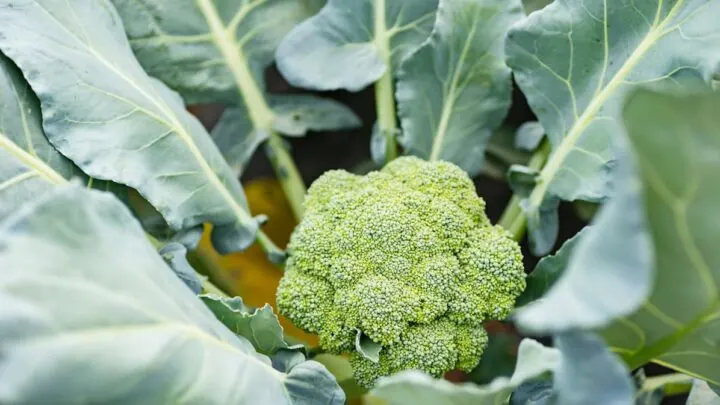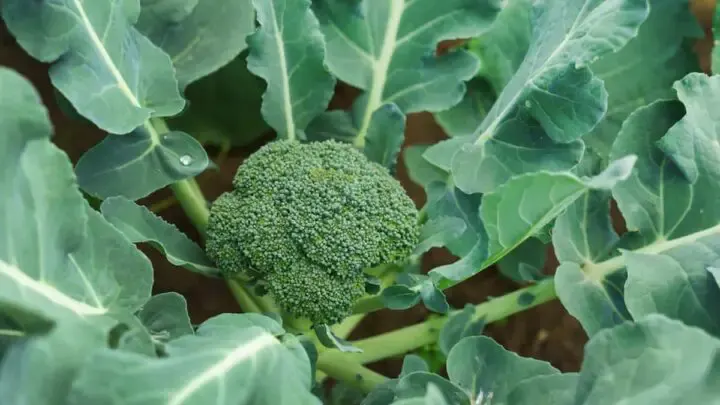Broccoli is a favorite among at-home gardeners, although it’s not always the easiest plant to keep healthy. Despite the challenges of growing broccoli, the joy of watching the edible crowns develop and grow as the plant matures towards harvest is worth the struggle. Because there are a variety of issues that can negatively affect the health of broccoli, some gardeners may be wondering, “why is my broccoli plant turning yellow?”
Broccoli plants turn yellow as a mature plant ages. However, if your broccoli plant has not reached full maturity, other potential causes could be a nutrient deficiency, insufficient light or water, disease, or a pest infestation.
Read on to learn more about the causes and solutions for broccoli plants turning yellow.

Causes & Solutions Of Broccoli Plants Turning Yellow
Identifying the root cause of your broccoli plant turning yellow and immediately implementing a solution strategy will usually heal the plant before too much damage can occur. This section explores these potential causes and solutions for a broccoli plant turning yellow.
Overly Mature
Broccoli is a short-season annual crop grown in spring and fall in many growing climates. Broccoli plants will reach harvest anywhere from 70 – 100 days from seed, depending on the variety. If broccoli crowns are left on the plant beyond its peak harvest time, the crown will begin to flower, causing the plant to yellow and potentially wilt.
Broccoli has fully matured and is ready to be harvested when the crown’s growth has slowed and is a deep green color.
Knowing the variety of broccoli you are growing and the predicted days to harvest can help to ensure that you harvest your broccoli at an appropriate time before too much aging has occurred. If over-aging is already underway, then it is recommended to immediately harvest and enjoy your broccoli crowns that are still green.

Insufficient Light Or Watering
Broccoli plants will thrive in full sun and frequent watering. As broccoli grows, keep the soil moist with regular watering at the plant’s base. As the plant approaches its harvest period, watering can be slightly decreased. If your broccoli plant has experienced periods of inconsistent light or watering, this may cause your broccoli plant to turn yellow.
Light and moisture issues can easily be prevented. To ensure sufficient lighting, observe your planned growing area before planting the broccoli. Does it get at least 6 hours of sun daily, and will that light continue throughout the growing season?
Sometimes the growth of spring vegetation can lead to unexpecting shading of our garden plots, so this is a valuable factor to consider. Creating a schedule for watering your broccoli plants can help to ensure they don’t go days without watering and become dehydrated.
If problems with insufficient light or watering of your broccoli plant are already underway, it’s important to take immediate action to avoid further yellowing or any other adverse health impacts. If the light is the cause, then moving the plant to a sunnier location is ideal.
As long as the plant is not nearing full maturity, it will most likely survive a transplant. If the plant has become dehydrated, begin providing water more frequently but in low doses to rehydrate it without drowning.

Nutrient Deficiency
Broccoli tends to thrive in nutrient-rich soil containing elements of calcium, potassium, iron, magnesium, zinc, and most of all, nitrogen. If broccoli is yellowing due to a nutrient deficiency, then it is most likely that the soil lacks nitrogen, but it is not out of the question that other nutrients could also be deficient.
If it has been determined that the yellowing of your broccoli plant is not due to its maturity, insufficient light, or watering, the next step will be to test your soil for nutrient deficiencies.
You can purchase soil tests at most garden centers and online. If deficiencies are identified, a variety of fertilizers on the market will supplement what your soil is lacking. Nutrient deficiencies can be prevented by starting plants in a nutrient-rich blend of soil and compost and periodically fertilizing with an all-purpose vegetable fertilizer.
Always be careful not to over-fertilize as this can also cause the plant to yellow and have negative health issues.
Diseases
Broccoli is highly susceptible to fungal diseases that can cause the plant to develop yellow spots. Fungus yellowing on broccoli first appears as small dots on leaves and spreads quickly.
If fungus leaf spots are identified, it’s crucial to immediately remove those leaves in hopes of not infecting the rest of the plant. If the fungus continues, it’s imperative to remove any infected plants so as not to infect your entire crop. Two main funguses affecting broccoli are club root and black rot.

Club Root
Club root is challenging to identify because it mainly affects the plant’s roots, causing them to swell. When the broccoli’s roots swell, they struggle to distribute water and nutrients throughout the plant properly.
The only above-ground identifiers of club root are the yellowing leaves that will eventually wilt and die. Because this could be a symptom of other issues, the only way to diagnose club root is to uproot the plant to look for swelling. It’s best to rule out other possible causes of the broccoli plant yellowing before resorting to inspecting for club root, as uprooting will probably kill the plant.
Black Rot
Black rot can be identified on broccoli by its yellow v-shaped fungus spots that develop on the edges of the leaves. Typically these spots are browner at the center and turn yellow towards the edges. If this type of spotting is noticed, it is almost undoubtedly black rot, and you should remove infected leaves immediately.
Black rot appears most in the hot and humid weather conditions of summer. It affects the plant’s veins, turning them black, which can sometimes be visible. Eventually, the veins will begin to ooze yellowy pus unique to a black rot infection.

Pests
Broccoli plants are vulnerable to several pests, and an infestation may cause the plant’s leaves to yellow. The most common pests affecting broccoli plants are aphids, cabbage worms, and mealy bugs. Typically these pests will congregate on the underside of the plant’s leaves, so they may not be visible at first, but as they multiply, they become more apparent.
Spraying plants daily with diluted neem oil can help to prevent pest infestations and mitigate them if they’ve already started. In addition, immediately removing any infested leaves from the plant will help to preserve what remains.
Resistant Broccoli Varieties
We’ve determined that broccoli is susceptible to several growing challenges. However, some varieties bear some resistance to disease and extreme temperatures. You may consider growing one or some of the following broccoli varieties to provide a higher chance for a healthy crop.
| Broccoli Variety | Disease Resistant? | Cold Resistant? | Heat Resistant? |
| Arcadia (86) | Yes | Yes | No |
| Eureka (87) | Yes | Yes | No |
| Greenbelt | Yes | No | No |
| Marathon F1 | Yes | Yes | No |
| Windsor (90) | Yes | Yes | Yes |
Final Tips On Growing Broccoli
Although broccoli is a finicky plant to grow, the rewards are worth the challenge. Because growing conditions vary greatly, it is recommended to research the best broccoli varieties to grow in your plant hardiness zone, as well as the best time to plant and harvest. Experimenting with different varieties and care can only lead to the development of a consistently successful broccoli harvest each growing season.

Hi there, my name is Allie and welcome to my blog; GareningWithAllie!
Much of what you see written here is just our personal experiences with gardening. Along with the content I write here, there is also a unique collection of gardening topics covered by some of our close friends. I hope you find everything you read here to be helpful, informative, and something that can make your gardening journey the most lovely experience ever! With that said, Happy Gardening!
